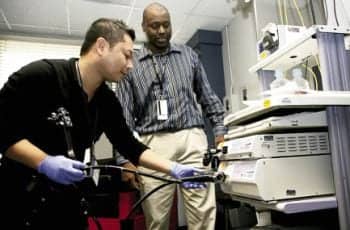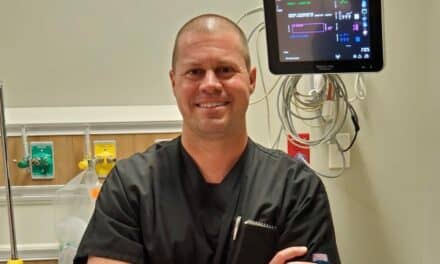 |
| First look agreements may cover cardiac catheterization labs, CTs, MRs, interventional radiology, CR readers, fluoroscopy, mammography, nuclear medicine, and ultrasound machines. PHOTO COURTESY OF SIEMENS HEALTHCARE |
The old saying goes, “If at first you don’t succeed, try, try again.” With a first look (or first call) agreement, if at first the biomed imaging tech does not succeed, he/she has the option to call the manufacturer.
First look contracts are shared service agreements, where the facility’s clinical/biomedical engineering technician or radiology equipment specialist takes responsibility for preventive maintenance on equipment as well as the “first look” at any problems. If the repairs fall into the biomed’s scope of experience, the problem will be taken care of in-house. If they extend outside of that range, the biomed often has options that include telephone guidance and/or on-site visits from the manufacturer.
Contract terms often address training requirements and parts ordering, but may not specify specific functions and tasks. The biomed is often trusted to determine at what point the manufacturer should be called.
The arrangement benefits both parties, with a positive impact on cost and care. Manufacturers are typically open to first look agreements, and they have become increasingly popular. Areas covered may include CTs, MRs, interventional radiology, CR readers, fluoroscopy, mammography, nuclear medicine, ultrasound machines, and cardiac catheterization labs.
“I think most midsize or larger facilities have some type of service contract with either biomed or radiology for co-op,” says Larry Rochowicz, CBET, CRES, a radiology biomed technician at The Reading Hospital and Medical Center located in West Reading, Pa. “Almost everybody I know has some type of contract on their equipment that would be either shared or parts.”
Looking Ahead
First look agreements are popular because they help facilities achieve some basic aims. “The primary objectives are quite simple: We want to improve uptime and reduce cost,” says Grant Smith, CRES, assistant director of imaging engineering and diagnostic support for Duke University Health System’s clinical engineering department, in Durham, NC.
When biomeds handle the easy repairs in-house it helps to achieve these goals. “This filters out minor problems with these systems as efficiently as possible,” says Tom Martin, CRES, senior field service specialist, clinical engineering, CHI-clinical engineering, at St Joseph Health System, Lexington, Ky.
Improved uptime positively impacts patient care. “It allows for optimal physician, technician, and patient satisfaction while managing costs,” says Stuart Newman II, a radiology engineer with the clinical equipment management program of Novant Health, Winston-Salem, NC.
The vendor benefits too. “This is a win-win for most everyone,” Martin says. “The vendor does not need to dispatch a service engineer for minor problems. The user gets the system back up quicker since vendor response times could be several hours. And, the in-house engineer justifies his/her position by being there to take care of these types of calls.”
Negotiating the Terms
Because manufacturers do see a resulting savings, they are often willing to negotiate a shared service agreement. Typically, this type of contract will cost less than a traditional service arrangement where the manufacturer handles all maintenance and repair.
“The vendors are open to shared service agreements,” says Gary Eshelman, another radiology technician at The Reading Hospital and Medical Center. “They can tell you upfront how much savings you will get going first call as opposed to a full-service contract.”
Better negotiators may be able to arrive at even better deals, as may those with more pieces of equipment. “If you have several of the same unit, the cost savings usually multiply as you add more of the same piece on,” Eshelman says, noting it is rarely a fixed price per piece.
Staying within a family of instruments can sometimes also lead to efficiencies in maintenance, which means that again, both the facility and the manufacturer benefit.
“As the facility wants to buy things, we want to be able to keep as close a companion to that equipment as possible down the hall or in the next room, so our experience translates more fluidly from room to room,” Smith says. “Obviously, if you go from GE to Siemens to Philips, it’s more difficult to manage. So, with us being involved and being able to effectively manage those assets, we become a good asset to help sell whoever the manufacturer is that we are supporting.”
Smith also recommends including parts in any shared service agreement, suggesting either negotiating for the purchase of parts at an exchange rate and stock call on failed items or for a role as depot so parts are stored on-site. “You can respond to your customers even faster,” he says.
Look Smart
The quick turnaround in active maintenance is often cited as the greatest advantage of a first look agreement. “The best advantage is that in-house service calls can usually be responded to within a few minutes,” Martin says. “Then, about 75% of the time, we are able to get the system back up quickly. This saves on downtime and the inconvenience of moving patients due to a down room.”
Newman concurs, saying, “As much as 80% of our service calls in imaging equipment are quick fixes, like a system reset. We just walk upstairs or next door, and we can quickly determine what the problem is.”
If the issue is repairable, the imaging specialist can fix it according to priority. “Often, for interventional and cardiac cath labs, with 80% of the calls that come in, the first thing you hear is, ‘There’s a patient on the table.’ So in those situations, there is an enormous benefit to being able to dispatch somebody in minutes rather than the normal response time from the vendor, who is a field service engineer,” Smith says.
Vendor engineers require time to get on-site from wherever they may be—which could be across town or in another city. “Right now, especially, our experience is that vendor engineers are stretched about as thin as they can possibly be stretched,” Newman says. “If I need to call service, at best we might be looking at an hour, but potentially it could be the next day.”
If the biomed tech can determine the nature of the problem, he/she can start the maintenance process, including identifying the issue and ordering any needed parts so they arrive more quickly. “MR, CT, cath labs, and interventional labs—on top of their diagnostic properties, they are also very important from a business point of view because of the revenue that is attached to them,” Eshelman says.
While increased uptime is often a primary objective of these agreements, other benefits exist as well. Preventive maintenance is easier to schedule, with greater flexibility. “In the event the facility has an unexpected patient load, we can reschedule easier, whereas a field service engineer has a specific time he is coming in here, driving back and forth to wherever he’s from, and it’s not as easy to change,” Eshelman says.
In addition, on-site technicians may have a better relationship with the clinicians and a better chance of catching an intermittent problem than an engineer who has to be called in. “They see us on a daily basis and may be more comfortable communicating problems to us,” Eshelman says, noting this is particularly true in cases of user error.
Technicians performing the first look also increase their value to the organization by handling these types of calls. In cases with a full service agreement where the in-house biomeds take a first look anyway, facilities should consider switching to a first call contract to take advantage of cost savings.
Tallying the Savings
First look agreements are often cheaper than their full service counterparts. Reductions range from 4% to 20%, depending on specific details, such as how many pieces of equipment are covered and the negotiating skills of the facility representative.
Smith has most often seen a 10% to 20% reduction in the contract price, “with little or no increase in liability, and parts still included,” Smith says. He provides an example: A facility has a full-service CT contract for $125,000, which it reduces to $105,000 with the implementation of a shared service agreement. The $20,000 savings represents a 16% reduction that is applied to every like CT machine in the facility. “In our case, we have 16 CTs, so we would see a $320,000 reduction in contract cost, but still have the tubes and parts included and the expertise of the manufacturer behind us,” Smith says.
Martin, whose facility covers two of seven CTs and two of seven heart catheterization laboratories, has often seen a 5% to 10% reduction in contract cost. The savings is helpful, but not always enough to justify use. “It is much more cost effective to train the in-house service engineer on the system and purchase a support-only contract,” Martin says.
In nearly all shared service agreements, vendor-specific training (whether by instrument and/or technology) is required before the OEM will agree to implement the terms of a shared service agreement.
“Almost always, with a first look agreement, the manufacturer will require that we have their OEM training at the level of the equipment that’s being covered on the shared agreement,” Smith says. “So if you have 16-slice CT, they will want you to be at the 16-slice school. If you have a 64-slice CT, they want you to be at their CT 64 class.”
Though they prefer not to approve of outside training facilities, Martin notes that third-party training and experience may count toward satisfying the requirement. Either way, training can be expensive.
Costs are estimated at roughly $1,000 to $1,500 per day, with classes ranging from 1 week to several weeks. Expenses, such as travel and food, are extra. “You could spend almost $100,000 in training to bring an entry-level technician up to the level required,” Smith says.
Many facilities negotiate the cost of training for at least one technician into the cost of the equipment’s acquisition price or service contract. “We’ll have training for one in-house person included every time we buy a new system,” says Felix Gorney, imaging specialist II, CHI-clinical engineering, Saint Joseph Health System, Lexington, Ky. If two systems are purchased, two technicians get training. He notes his last two classes were attended entirely by in-house biomeds.
To ensure depth of service, vendor-trained biomeds can then train others in-house to help ensure system uptime. Gorney notes the vendor has been willing to cover in times when no backup is available.
Facilities may decide to forego the first call option and its extra cost of training on equipment where there will be a limited return on the investment. “We wouldn’t send somebody to $50,000 mammography school if we had only one or two of the devices,” Smith says.
The cost of training will need to be balanced against the service contract savings to ensure a return. “We justify our training with the cost of training divided by the savings over the length of the first call contract. Typically, accountants like to see a return on investment of less than 1 year,” Eshelman says.
|
Find imaging vendors in the Buyer’s Guide. |
This can vary with accountant and facility; the number of devices and engineers will impact the time until return. Martin provides an example using a first look contract savings of $10,000 per year per system and $40,000 for training per engineer: “In our case, it would be 2 years to break even on this investment. However, if you doubled the quantity of systems to four per in-house engineer, then the breakeven time would be 1 year. This quantity is feasible if the in-house person is not overwhelmed with other responsibilities,” Martin says.
In general, most biomeds find shared service agreements work well. “I would say it seems it’s always a win-win situation for the biomed department and for the OEM manufacturers,” Rochowicz says.
Renee Diiulio is a contributing writer for 24×7. For more information, contact .






